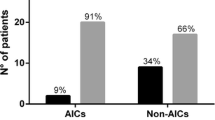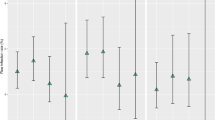Abstract
Objective
Antibiotic-impregnated shunt (AIS) systems have been designed to prevent the colonization of shunt components by skin flora that occurs at surgery. Although such systems may decrease the incidence of early shunt infections (those occurring within 6 months of shunt placement), it is unclear if such exposure to prolonged antibiotics leads to an increased incidence or virulence of late shunt infections (those occurring later than 6 months after shunt placement). In this study, the authors evaluate the incidence of late shunt infection after the introduction of an AIS system in a pediatric hydrocephalus population.
Materials and methods
We prospectively reviewed all pediatric patients undergoing antibiotic-impregnated CSF shunt insertion or shunt revision operations at our institution for the 33 month period between October 1, 2002 and June 31, 2005. All shunt-related complications, including shunt infection, were evaluated in those patients with later than 6 months of follow-up.
Results
A total of 153 pediatric patients (between 1 and 21 years of age) underwent 262 shunting procedures involving the use of antibiotic-impregnated catheters. All patients were followed-up for later than 6 months with a mean follow-up of 21.7 months (range 13–46 months). Ten patients (3.82%) experienced an early shunt infection within the 6-month follow-up period. No patients experienced a late shunt infection.
Conclusion
Although concern exists that AIS systems may delay shunt infections or even increase the rate or virulence of such infections, introduction of such catheters into a pediatric hydrocephalus cohort does not significantly increase incidence of late CSF shunt infection compared to historic controls.

Similar content being viewed by others
References
Baird C, O’Connor D, Pittman T (1999) Late shunt infections. Pediatr Neurosurg 31:269–273
Bayston R, Grove N, Siegel J, Lawellin D, Barsham S (1989) Prevention of hydrocephalus shunt catheter colonisation in vitro by impregnation with antimicrobials. J Neurol Neurosurg Psychiatry 52:605–609
Bayston R, Lambert E (1997) Duration of protective activity of cerebrospinal fluid shunt catheters impregnated with antimicrobial agents to prevent bacterial catheter-related infection. J Neurosurg 87:247–251
Blount J, Campbell J, Haines S (1993) Complications in ventricular cerebrospinal fluid shunting. Neurosurg Clin N Am 4:633–656
Bondurant CP, Jimenez DF (1995) Epidemiology of cerebrospinal fluid shunting. Pediatr Neurosurg 23:254–258 (discussion 259)
Chadduck W, Adametz J (1988) Incidence of seizures in patients with myelomeningocele: a multifactorial analysis. Surg Neurol 30:281–285
Chapman PH, Borges LF (1984) Shunt infections: prevention and treatment. Clin Neurosurg 32:652–664
Enger P, Svendsen F, Wester K (2003) CSF shunt infections in children: experiences from a population-based study. Acta Neurochir (Wien) 145:243–248 (discussion 248)
Fan-Havard P, Nahata MC (1987) Treatment and prevention of infections of cerebrospinal fluid shunts. Clin Pharm 6:866–880
Gardner P, Leipzig T, Phillips P (1985) Infections of central nervous system shunts. Med Clin North Am 69:297–314
George R, Leibrock L, Epstein M (1979) Long-term analysis of cerebrospinal fluid shunt infections. A 25-year experience. J Neurosurg 51:804–811
Govender S, Nathoo N, van Dellen J (2003) Evaluation of an antibiotic-impregnated shunt system for the treatment of hydrocephalus. J Neurosurg 99:831–839
Haines SJ, Walters BC (1994) Antibiotic prophylaxis for cerebrospinal fluid shunts: a metanalysis. Neurosurgery 34:87–92
Hampl J, Schierholz J, Jansen B, Aschoff A (1995) In vitro and in vivo efficacy of a rifampin-loaded silicone catheter for the prevention of CSF shunt infections. Acta Neurochir (Wien) 133:147–152
Hampl J, Weitzel A, Bonk C, Kohnen W, Roesner D, Jansen B (2003) Rifampin-impregnated silicone catheters: a potential tool for prevention and treatment of CSF shunt infections. Infection 31:109–111
Kanev P, Sheehan J (2003) Reflections on shunt infection. Pediatr Neurosurg 39:285–290
Kockro R, Hampl J, Jansen B, Peters G, Scheihing M, Giacomelli R, Kunze S, Aschoff A (2000) Use of scanning electron microscopy to investigate the prophylactic efficacy of rifampin-impregnated CSF shunt catheters. J Med Microbiol 49:441–450
Kohnen W, Schaper J, Klein O, Tieke B, Jansen B (1998) A silicone ventricular catheter coated with a combination of rifampin and trimethoprim for the prevention of catheter-related infections. Zentralbl Bakteriol 287:147–156
Langley J, LeBlanc J, Drake J, Milner R (1993) Efficacy of antimicrobial prophylaxis in placement of cerebrospinal fluid shunts: meta-analysis. Clin Infect Dis 17:98–103
McGirt MJ, Leveque JC, Wellons JC 3rd, Villavicencio AT, Hopkins JS, Fuchs HE, George TM (2002) Cerebrospinal fluid shunt survival and etiology of failures: a seven-year institutional experience. Pediatr Neurosurg 36:248–255
Ronan A, Hogg G, Klug G (1995) Cerebrospinal fluid shunt infections in children. Pediatr Infect Dis J 14:782–786
Schierholz J, Pulverer G (1997) Development of a new CSF-shunt with sustained release of an antimicrobial broad-spectrum combination. Zentralbl Bakteriol 286:107–123
Sciubba DM, Stuart RM, McGirt MJ, Woodworth GF, Samdani AF, Carson BS, Jallo GI (2005) Effect of antibiotic-impregnated shunt catheters in decreasing the incidence of shunt infection in the treatment of hydrocephalus. J Neurosurg 103:131–136
Smith E, Butler W, Barker FG 2nd (2004) In-hospital mortality rates after ventriculoperitoneal shunt procedures in the United States, 1998 to 2000: relation to hospital and surgeon volume of care. J Neurosurg 100:90–97
Vinchon M, Lemaitre M, Vallee L, Dhellemmes P (2002) Late shunt infection: incidence, pathogenesis, and therapeutic implications. Neuropediatrics 33:169–173
Walters BC, Goumnerova L, Hoffman HJ, Hendrick EB, Humphreys RP, Levinton C (1992) A randomized controlled trial of perioperative rifampin/trimethoprim in cerebrospinal fluid shunt surgery. Childs Nerv Syst 8:253–257
Walters BC, Hoffman HJ, Hendrick EB, Humphreys RP (1984) Cerebrospinal fluid shunt infection. Influences on initial management and subsequent outcome. J Neurosurg 60:1014–1021
Author information
Authors and Affiliations
Corresponding author
Rights and permissions
About this article
Cite this article
Sciubba, D.M., McGirt, M.J., Woodworth, G.F. et al. Prolonged exposure to antibiotic-impregnated shunt catheters does not increase incidence of late shunt infections. Childs Nerv Syst 23, 867–871 (2007). https://doi.org/10.1007/s00381-007-0334-5
Received:
Revised:
Published:
Issue Date:
DOI: https://doi.org/10.1007/s00381-007-0334-5




